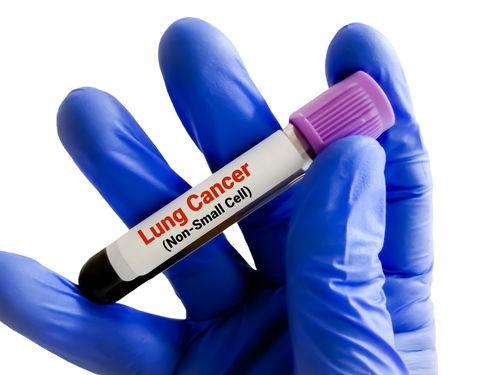
Attendees of the European Society for Medical Oncology (ESMO) Congress 2023 might have noticed a theme among the late-breaking abstracts chosen for presentation during the conference’s three Presidential Sessions. Of the 15 abstracts selected, seven were focused on the field of non-small cell lung cancer (NSCLC), and five of these seven discussed first-line treatment options in either the locally advanced/metastatic disease setting or in early-stage resectable disease.1
The majority of patients with advanced NSCLC will receive frontline treatment with immunotherapy with or without chemotherapy, depending on PD-L1 expression. However, the data presented at ESMO reflected the fact that there are a growing number of patients with advanced NSCLC that will be found to have actionable genomic alterations.
“Clinicians now have nine biomarker subsets that we have to test for because we have this growing number of targeted therapies that provide benefits to patients with advanced disease,” said Balazs Halmos, MD, director of the Multidisciplinary Thoracic Oncology Program at Montefiore Medical Center and a professor of medicine at Albert Einstein College of Medicine.
For advanced or metastatic disease, the National Comprehensive Cancer Network guidelines suggest molecular testing for EGFR, KRAS, ALK, ROS1, BRAF, NTRK1/2/3, MET, RET, and ERBB2 (HER2).2
“We all have to get used to the fact that we have to do biomarker testing and understand the biomarker profile because there have been advances for each and every subset,” Dr. Halmos said.
EGFR
One of the areas of advancement represented with abstracts out of the ESMO Congress 2023 related to a large subset of patients with NSCLC, those with EGFR mutations, which makes up approximately 10% to 15% of patients in the United States and up to 50% of patients in countries like China, Korea, and Japan.
The MARIPOSA trial studied the use of the bispecific antibody amivantamab-vmjw, an intravenous monoclonal antibody that is directed against EGFR and MET and is already used in the second-line setting for EGFR exon 20-mutated disease, explained James Stevenson, MD, vice-chairman of the Department of Hematology and Medical Oncology at the Cleveland Clinic.
MARIPOSA randomly assigned patients to amivantamab plus the EGFR tyrosine kinase inhibitor (TKI) lazertinib, the EGFR TKI osimertinib alone, or lazertinib alone. Amivantamab plus lazertinib yielded a 30% reduction in the risk for disease progression or death compared with osimertinib (hazard ratio [HR], 0.70; 95% CI, 0.58-0.85; P<.001) and a more than 7-month improvement in median progression-free survival (PFS; 23.7 months vs 16.6 months).3
“Osimertinib has been the standard of care for years, and these data could potentially be practice changing,” Dr. Stevenson said.
MARIPOSA should also be looked at in the context of the FLAURA2 trial results, which showed that osimertinib plus chemotherapy significantly improved PFS compared with osimertinib monotherapy (25.5 months vs 16.7 months) in this patient population, with even more robust benefits seen in patients with central nervous system (CNS) disease.4
“We have two randomized trials that showed improvement in frontline efficacy, one with a targeted therapy combination and the other with targeted therapy plus chemotherapy,” Dr. Stevenson said. “Scientifically, it is more appealing to add a targeted therapy to a TKI backbone to treat these patients versus simply adding chemotherapy.”
Dr. Halmos noted, though, that amivantamab plus lazertinib may be a complicated combination in terms of toxicity and co-management.
“This regimen comes with quite a bit of toxicity, and we need to consider whether it is appropriate for each patient,” Dr. Halmos said. “There was a high risk for dermatologic toxicity and infusion reactions and an unexpectedly high rate of venous thromboembolism events to the point that prophylactic anticoagulation will be recommended for patients for at least 4 months.”
Appropriate management of side effects may also be a concern with the combination of amivantamab plus chemotherapy studied in the PAPILLON trial, which compared the regimen with chemotherapy alone in patients with EGFR exon 20 insertion-mutated advanced NSCLC. Combination treatment resulted in a 60% reduction in the risk for progression or death compared with chemotherapy alone (HR, 0.395; 95% CI, 0.30-0.53; P<.001).5 Adverse events with amivantamab plus chemotherapy led to dose interruptions in almost 70% of patients and dose reductions in almost 50%.
“Very recently this group of patients had no promising targeted therapy, and all of a sudden we have had some real advances,” said Jonathan Goldman, MD, an associate professor of medicine at the University of California, Los Angeles. “The addition of amivantamab to chemotherapy had meaningful improvement in response rates and PFS, and although [overall survival (OS)] data are still immature, you can see separation of the curves, which is encouraging.”
ROS1
Outside of data presented at ESMO, one of the biggest splashes recently was the US Food and Drug Administration (FDA) approval of the ROS1 TKI repotrectinib, according to Dr. Halmos. Repotrectinib was granted approval for locally advanced or metastatic ROS1-positive NSCLC for patients who are TKI-naive and those who have previously received an ROS1 TKI.6
The approval was based on results of TRIDENT-1, an open-label trial that included 71 patients with ROS1-positive locally advanced or metastatic NSCLC who had received up to one prior line of platinum-based chemotherapy and/or immunotherapy. This group of ROS1 TKI-naive patients had an overall response rate (ORR) of 79% and a median duration of response of 34.1 months.7
“Repotrectinib appears to be an excellent agent with a safety profile that is quite reasonable, with dizziness as the most notable toxicity and terrific efficacy in frontline ROS1 TKI-naive patients,” Dr. Halmos said. “It is not the only choice, with entrectinib, crizotinib, or ceritinib all having proven activity for these patients, but I think repotrectinib might make it to the front of this line, given its excellent activity.”
Dr. Stevenson agreed that with its seemingly better safety profile, repotrectinib will likely be an excellent new standard of care for patients with ROS1-positive disease.
RET
The ESMO Congress 2023 also included data from the confirmatory LIBRETTO-431 trial on the use of selpercatinib in advanced RET fusion-positive NSCLC. Median PFS for patients assigned selpercatinib was more than doubled compared with chemotherapy plus pembrolizumab (24.8 months vs 11.2 months; HR, 0.465; 95% CI, 0.309-0.699; P=.0002) or chemotherapy alone (24.8 months vs 11.2 months; HR, 0.482; 95% CI, 0.331-0.700; P<.001), and time to CNS progression was also significantly improved.8
The FDA approved selpercatinib for this patient population in September 2022,9 but the European Medicines Agency granted only conditional approval, asking for postmarketing randomized data comparing it with the current standard of care.
“To see that PFS and response rate were much improved with this targeted therapy in the frontline setting versus chemotherapy was great validation for the current use of this drug,” Dr. Stevenson said. “We have had some other follow-ups to phase 2 data that, when randomized against a standard of care like chemotherapy, have not looked as impressive. It is important that these confirmatory trials get done when drugs receive accelerated approval based on phase 2 data.”
Additionally, Dr. Halmos said these data should further push clinicians to make sure that RET testing is being completed as part of the upfront biomarker testing package.
KRASG12C
Updated results of the phase-2 KRYSTAL-7 trial evaluating concurrent adagrasib plus pembrolizumab as frontline treatment for patients with KRASG12C–mutated NSCLC were also presented at ESMO. In patients with a PD-L1 tumor proportion score (TPS) ³50%, the combination demonstrated an ORR of 63% and a median PFS that has not been reached with 10.1 months follow-up.10
“A large subset we face in the clinic is KRAS mutations, so we now have welcome data with the KRASG12C-targeting inhibitors sotorasib and adagrasib, both of which have reasonable but not overly impressive single-agent activity,” Dr. Halmos said. “The key question is whether these agents could make an impact in frontline management. Currently, adagrasib plus pembrolizumab is looking like a quite active and reasonably safe combination, and we look forward to seeing phase 3 data in this setting.”
Dr. Halmos noted that the field is also learning about the CNS activity of adagrasib, which elicited intracranial activity in patients with untreated CNS metastases.11 It is encouraging that the field is moving rapidly forward, he said, with a new generation of similar agents in development in clinical trials, including Genentech’s divarasib and a highly exciting RASmulti inhibitor from Revolution Medicine.
Early-Stage Resectable Disease
Another important challenge clinicians face is how to optimally treat patients going to surgery, Dr. Goldman said.
The Checkmate 816 regimen using three cycles of neoadjuvant nivolumab plus chemotherapy for patients with stage IB-IIIA resectable NSCLC “ushered in a new era of perioperative treatment, providing what looks to be very meaningful and long-standing benefit for a subset of patients,” Dr. Goldman said.
The ESMO Congress 2023 included data from three additional trials looking at a similar approach but adding immunotherapy or a targeted therapy for about a year after surgery.
First, CheckMate 77T compared neoadjuvant nivolumab plus chemotherapy with neoadjuvant placebo plus chemotherapy followed by surgery and adjuvant nivolumab or placebo in previously untreated resectable stage II-IIIb NSCLC.12 Risk for progression or death was reduced by 42% with nivolumab plus chemotherapy followed by adjuvant nivolumab compared with neoadjuvant placebo plus chemotherapy followed by adjuvant placebo.
Full results of KEYNOTE-671 showed that neoadjuvant pembrolizumab plus chemotherapy followed by resection and adjuvant pembrolizumab significantly improved OS (HR, 0.72; 95% CI, 0.56-0.93; P=.00517) and event-free survival (HR, 0.59; 95% CI, 0.48-0.72) compared with neoadjuvant placebo plus chemotherapy and adjuvant placebo in patients with stage II-IIB NSCLC.13
“We don’t have comparative trials, so we are stuck trying to compare data between trials, but the pembrolizumab trial does stand out for the reported OS benefit,” Dr. Goldman said.
Dr. Halmos also noted that further data on treatment decisions after neoadjuvant therapy were particularly needed for patients who do not achieve a pathological complete response. When it comes to adjuvant immunotherapy, based on the Impower10 and PEARLS studies, both atezolizumab (for stage II/IIIA, PD-L1 TPS >1%) and pembrolizumab (stage IB-IIIA) have been approved by the FDA; however, uncertainties as to proper patient selection and OS benefits remain. Although pembrolizumab in this context is approved for all-comers, he would ideally like to incorporate biomarker testing into his decision-making process.
In the realm of targeted therapies, results of the ALINA trial showed that adjuvant treatment with the oral ALK inhibitor alectinib resulted in a 76% reduced risk for recurrence or death compared with chemotherapy for patients with ALK-positive stage II-IIIA NSCLC (HR, 0.24; 95% CI, 0.13-0.45; P<.0001).14
“This benefit is similar to what was seen with the ADAURA trial of osimertinib, but with the unique twist of taking the chemotherapy component out of the equation,” Dr. Stevenson said. “There are no survival data for alectinib yet, but based on the ADAURA experience, there are reasons to expect that alectinib will improve survival and become a new standard of care for these patients.”
Dr. Halmos said that as the results are highly impressive, clinicians should consider discussing this option with appropriate patients. However, he also noted that clinicians may struggle to decide whether to follow the study’s approach—which omitted the addition of chemotherapy—or take a more conventional approach by offering chemotherapy followed by a targeted therapy.
Need for New Second-line Options
The trials presented at ESMO did not include all of the options being explored in the frontline setting. For example, frontline combination studies are looking at antibody-drug conjugates targeting anti-Trop-2, such as sacituzumab govitecan and datopotamab deruxtecan.
Additionally, as more immunotherapies and targeted therapies move to the frontline, patients will again be facing a need for novel therapies in the second line and beyond.
“We see over and over in oncology that we identify a great new second-line option and then study it as a first-line treatment,” Dr. Goldman said. “Then we are left again looking for a better second-line option.”
However, he hopes that the rapid acceleration of drug development seen in recent years will continue to provide new options for the second line and beyond.
“In the last 3 to 5 years we have seen the dramatic benefits that clinical trials provide, even for patients on the trials, with drugs in phase 1 or phase 3 trials quickly becoming new standards of care,” Dr. Goldman said. “The main hope is that the pace of development keeps up and we continue to have exciting new drugs come in from the second and third line.”
Leah Lawrence is a freelance health writer and editor based in Delaware.
References
- ESMO Congress 2023 – conference calendar. ESMO. Accessed December 5, 2023. https://cslide.ctimeetingtech.com/esmo2023/attendee/confcal/session
- NCCN Guidelines. Non-Small Cell Lung Cancer. National Comprehensive Cancer Network. Accessed December 5, 2023. www.nccn.org/professionals/physician_gls/pdf/nscl.pdf
- Cho BC, Felip E, Spira AI, et al. Amivantamab plus lazertinib vs osimertinib as first-line treatment in patients with EGFR-mutated, advanced non-small cell lung cancer (NSCLC): primary results from MARIPOSA, a phase III, global, randomized, controlled trial. Abstract LBA14. Presented at the ESMO Congress 2023; October 20-24, 2023; Madrid, Spain.
- Planchard D, Jänne PA, Cheng Y, et al. Osimertinib with or without chemotherapy in EGFR-mutated advanced NSCLC. N Engl J Med. 2023;389:1935-1948. doi:10.1056/NEJMoa2306434
- Zhou C, Tang K-J, Cho BC, et al. Amivantamab plus chemotherapy in NSCLC with EGFR exon 20 insertions. N Engl J Med. 2023; 389:2039-2051. doi:10.1056/NEJMoa2306434
- FDA approves repotrectinib for ROS1-positive non-small cell lung cancer. FDA. Accessed December 6, 2023. www.fda.gov/drugs/resources-information-approved-drugs/fda-approves-repotrectinib-ros1-positive-non-small-cell-lung-cancer
- Cho BC, Lin J, Camidge DR, et al. Pivotal topline data from the phase 1/2 TRIDENT-1 trial of repotrectinib in patients with ROS1+ advanced non-small cell lung cancer (NSCLC). Eur J Cancer. 2022;174(suppl 1):S1-S2. doi:10.1016/S0959-8049(22)00812-7
- Loonh HHF, Goto K, Solomon BJ, et al. Randomized phase III study of first-line selpercatinib versus chemotherapy and pembrolizumab in RET fusion-positive NSCLC. Abstract LBA4. Presented at the ESMO Congress 2023; October 20-24, 2023; Madrid, Spain.
- FDA approves selpercatinib for locally advanced or metastatic RET fusion-positive solid tumors. FDA. Accessed December 8, 2023. www.fda.gov/drugs/resources-information-approved-drugs/fda-approves-selpercatinib-locally-advanced-or-metastatic-ret-fusion-positive-solid-tumors
- Garassino MC, Theelen WSME, Jotte R, et al. KRYSTAL-7: efficacy and safety of adagrasib with pembrolizumab in patients with treatment-naïve, advanced non-small cell lung cancer (NSCLC) harboring a KRASG12C Abstract LBA65. Presented at the ESMO Congress 2023; October 20-24, 2023; Madrid, Spain.
- Negrao MV, Spira AI, Heist RS, et al. Intracranial efficacy of adagrasib in patients from the KRYSTAL-1 trial with KRASG12C-mutated non–small-cell lung cancer who have untreated CNS metastases. J Clin Oncol. 2023. doi:10.1200/JCO.23.00046
- Cascone T, Awad MM, Spicer JD, et al. CheckMate 77T: phase III study comparing neoadjuvant nivolumab plus chemotherapy vs neoadjuvant placebo plus chemotherapy followed by surgery and adjuvant nivolumab or placebo for previously untreated, resectable stage II-IIIb NSCLC. Abstract LBA1. Presented at the ESMO Congress 2023; October 20-24, 2023; Madrid, Spain.
- Spicer JD, Gao S, Liberman M, et al. Overall survival in the KEYNOTE-671 study of perioperative pembrolizumab for early-stage non-small-cell lung cancer (NSCLC). Abstract LBA56. Presented at the ESMO Congress 2023; October 20-24, 2023; Madrid, Spain.
- Solomon BJ, Ahn JS, Dziadziuszko R, et al. ALINA: efficacy and safety of adjuvant alectinib versus chemotherapy in patients with early-stage ALK+ non-small cell lung cancer (NSCLC). Abstract LBA2. Presented at the ESMO Congress 2023; October 20-24, 2023; Madrid, Spain.







 © 2025 Mashup Media, LLC, a Formedics Property. All Rights Reserved.
© 2025 Mashup Media, LLC, a Formedics Property. All Rights Reserved.